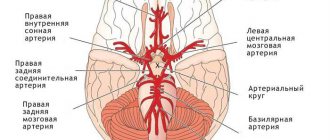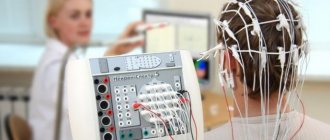Paralysis
called the complete loss of voluntary movements in various parts of the body. This symptom occurs in many diseases of the nervous system.
Voluntary movements of human skeletal muscles are controlled by the motor area of the cerebral cortex. It contains giant nerve cells (they are called pyramidal neurons), the processes of which descend into the spinal cord.
In the spinal cord, the process of each pyramidal cell transmits a nerve impulse to the next neuron, which carries it to the corresponding muscle. If this chain is interrupted by a congenital malformation, injury or disease, paralysis occurs.
Causes and mechanism of development
Paralysis may result from the following pathological processes:
- space-occupying formations in the brain or spinal cord;
- acute disturbance of cerebral or spinal circulation;
- brain abscesses;
- spinal and traumatic brain injuries;
- demyelinating diseases (multiple encephalomyelitis, multiple sclerosis);
- inflammation of the spinal cord or brain.
Paralysis develops from poisoning with nerve paralytic and industrial poisons, salts of heavy metals, alcohol and its surrogates, and other toxic substances.
The cause of loss of voluntary movements can be myasthenia gravis, botulism, epilepsy, immunoinflammatory diseases, mechanical damage to the brain substance. Neurologists detect paralysis in patients suffering from motor neuron diseases (spinal muscular atrophy, amyotrophic lateral sclerosis). Voluntary movements of skeletal muscles are controlled by the motor area of the cerebral cortex. It contains pyramidal neurons - giant nerve cells, the processes of which descend into the spinal cord. There, the process of each pyramidal cell transmits a nerve impulse to the next neuron, which carries it to the corresponding muscle. When the chain is interrupted as a result of a congenital malformation, pathological process or damage, paralysis occurs.
Paresis and paralysis
Experts' opinions:
Sysuev Oleg Mikhailovich
Spine treatment
Video on the topic:
all videos on the topic
What are paresis and paralysis
A condition in which motor power is completely lost (paralysis) or motor function is weakened (paresis) due to pathologies of the nervous system that cause disturbances in the motor analyzer.
Unlike paresis, with paralysis the patient cannot consciously or physically move the limbs. The affected organ does not follow the commands of the central nervous system.
Causes
The cause of the two pathological conditions is the loss of muscle strength due to damage to the central and peripheral nervous system. Depending on the severity, one or both limbs are immobilized at once.
The provocateur is a violation of the vascular supply of the spinal cord or brain. Sometimes paresis or paralysis occurs due to injury, hemorrhage, or inflammation of the brain. Less commonly, the cause is multiple sclerosis.
Experts have formulated the causes of paresis and paralysis as follows:
- pathologies of the central nervous system, which include degenerative diseases, hemorrhagic stroke, destruction of motor neurons of the spinal cord and mechanical damage to the cerebral cortex,
- pathologies of the affected organ or limb, consisting of muscle atrophy, injury to the musculo-ligamentous apparatus,
- pathologies of the communication system. This includes damage to the connection between muscles and the central nervous system and damage to neuronal conduction channels due to which nerve impulses do not reach a limb or organ.
These conditions are often diagnosed due to advanced forms of radiculitis, vasculitis, injuries to peripheral nerves, and diseases of the nervous system of the demyelinating type.
Symptoms and types
There are several types of pathologies, the symptoms of which differ from each other:
- central paralysis It affects the entire surface of the leg or arm, as well as part of the torso. The muscle tone is increased unevenly, so it becomes difficult to straighten the elbow and flex the shin at the knee. The patient's leg is straight, and the arm is bent and is closer to the body, the gait is disturbed,
- peripheral paresis or paralysis. Muscles atrophy, their tone is reduced. Limbs constantly twitch, reflexes decrease,
- facial nerve paralysis. When closing the eyes, the eyelids remain slightly raised. Due to the constantly slightly open eye, the outflow of tears is disrupted, lacrimation increases,
- Paresis of facial muscles. The face is skewed in the healthy direction. It is impossible to raise the eyebrows; there are no folds on the forehead. There is difficulty closing the eyelids. The mouth is skewed in the healthy direction, the nasolabial fold is absent. The patient has difficulty chewing food.
It should be noted that there is a separate type of paralysis - sleepy paralysis. It is caused by sleep phase disturbances. Sleep paralysis lasts several minutes and is due to the fact that motor activity is still disabled and delayed, and the patient has already awakened in the REM sleep phase. The symptoms are as follows: in a dream, the patient is aware of his immobility, the dream is supplemented by hallucinations and illusions.
Paresis extends to one limb (monoparesis), to both limbs (paraparesis), to arms and legs at the same time (tetraparesis), to one half of the body (hemiparesis).
Which doctor should I contact for paresis and paralysis?
Treatment of paresis and paralysis is the responsibility of a neurologist. The specialist will conduct an examination at the Kuntsevo Treatment and Rehabilitation Center and prescribe therapy. The sooner a patient seeks medical help, the greater the chance of a quick recovery.
Treatment methods
There is no single treatment regimen. After establishing the causes of paresis or paralysis, the neurologist selects medications - muscle relaxants, antispasmodics, vitamin B complexes, which are used separately or together, neuroprotectors that protect nerve fibers, drugs to improve cerebral circulation with antiplatelet and antihypoxic effects.
A mandatory step is gymnastics and therapeutic massage, as well as physiotherapy. If the form of the pathology is sluggish, then sessions are scheduled immediately. In acute forms of paresis or paralysis, physiotherapy is carried out after a course of anticholinesterase drugs.
The following methods are most effective:
- UHF therapy,
- microwave therapy,
- electrophoresis with calcium and novocaine,
- ultrasound therapy,
- acupuncture,
- ultraviolet therapy.
Physiotherapy is involved when signs of functioning of paralyzed nerves and muscles appear. At the same time, a massage is performed to improve blood circulation and rapid drainage of lymph from the area of the paralyzed nerve, prevent muscle atrophy, and stimulate nerve impulses. At the same time, the risk of complications to the eyes, heart and blood vessels is eliminated.
results
The favorable prognosis for treatment of paresis and paralysis is influenced by the nature of nerve damage. Concussion, ischemia, sprains, and nerve bruises are completely eliminated with proper treatment. Paresis and paralysis due to prolonged compression, tearing, rupture, or crushing of nerves take longer to treat.
The first improvements are noticeable after a few weeks of strict adherence to the neurologist’s instructions, and pronounced positive dynamics occur no earlier than after 2-4 months. It is impossible to name the exact time frame for the recovery of paralyzed organs and muscles.
Rehabilitation and lifestyle restoration
Along with treatment in the clinic, you need to move more and work out the affected muscles. The doctor shows a series of physical therapy exercises that the patient should perform at home on his own. It is important to fully follow the neurologist’s instructions and not attempt self-treatment.
The risk of relapse remains throughout the year, so you need to lead an active lifestyle, completely give up smoking and alcohol, moderate physical activity and maintain a day-night routine. Any diseases must be treated promptly, as they can serve as an impetus for secondary paresis or paralysis.
Return to list
Kinds
Motor nerve cells, which are located in the spinal cord, not only receive and transmit nerve impulses from the brain.
They themselves carry out simple reflexes and partially regulate muscle tone. For example, when a person unconsciously withdraws his hand from a hot object, his brain takes almost no part in this, since the nerve chain is closed in the spinal cord. Therefore, when the cerebral cortex is damaged, the muscles become flaccid only for a while. Then their tone increases, reflexes strengthen, but voluntary movements are still impossible. This type of movement disorder is called spastic paralysis.
When motor nerve cells in the spinal cord or peripheral nerves are damaged, nerve impulses to the corresponding muscles cease to flow at all. They become lethargic and decrease in size over time. Muscle atrophy develops. Neurologists call this type of paralysis flaccid.
Make an appointment
In which muscles can paralysis develop?
Paralysis, depending on the damage to one or another part of the nervous system, can develop in different parts of the body. Paralysis in different muscle groups has the following names:
- paralysis of one upper or lower limb - monoplegia;
- paralysis of both legs or arms - paraplegia (occurs when the spinal cord is damaged);
- paralysis of the left or right half of the body - hemiplegia (develops in patients suffering from stroke);
- tetraplegia – paralysis of all four limbs,
- Neurologists call paralysis of the facial muscles prosopoplegia.
1.General information
First of all, let’s define, as always, the terminology. Paralysis is complete and unconditional immobility of an organ or system for which motor activity is the main natural function. This is the inability of the patient to cause such activity "from within" - neither by conscious nor unconscious effort of will, while from the outside, for example, a paralyzed leg can be rotated at the hip joint or bent at the knee with the help of one's own hands or the hands of another person. This is the difference between paralysis, say, muscle spasm or joint contracture, when such movement is impossible in principle; The term “paralysis” emphasizes precisely the inability of the affected organ to carry out the command of the central nervous system.
Paresis translated from Greek means “weakening, loss of strength”; this term refers to incomplete paralysis (which, by the way, is also translated as “relaxation”), when the available muscle effort or the original range of possible movements is partially preserved; the degree of this preservation can vary widely.
As a synonym for the concept of “paralysis”, the term “plegia” (“stroke”) is often used, which is semantically close to the concepts of “apoplexy” and “stroke” - which apparently formed the etymological basis of the outdated Russian phraseological units “suffered a blow” ", "paralysis after a blow", "apoplexy", etc. However, in modern medical terminology, the word "plegia" is usually used with qualifying prefixes: hemiplegia (one-sided paralysis), mono-, para- or tetraplegia (respectively, paralysis of one , both same-level or all four limbs).
A must read! Help with treatment and hospitalization!
Symptoms
The main symptom of paralysis is a lack of muscle strength in the affected muscle or muscle group. Depending on which muscle is affected, the patient may have impaired gait, drooping head and foot, and lack of muscle strength in the limbs. Cranial nerve palsies are manifested by the following symptoms:
- impaired movement of the eyeballs;
- nasality;
- slurred speech;
- sluggishness of the tongue;
- other symptoms that are associated with weakness or complete dysfunction of the facial muscles.
Signs of central paralysis directly depend on the level of damage. If the pathological process develops in the central gyrus of the cerebral cortex, the function of the upper and lower limbs falls on the opposite side of the pathological focus. When the pyramidal fibers of the brainstem of the head are damaged, hemiplegia occurs on the opposite side, combined with central paralysis of the muscles of the face and half of the tongue. Bilateral central motor neuron damage to the cranial nerves results in pseudobulbar palsy.
Central paralysis is manifested by the following symptoms:
- an increase in tendon reflex perceptions, which is accompanied by an expansion of the reflexogenic zone;
- muscle maintenance;
- the occurrence of pathological reflexes and synkinesis (involuntary movements of a limb or other parts of the body that accompany another passive or voluntary movement).
Increased muscle tone occurs reflexively. At the same time, the muscles are in constant tension. Resistance to passive movements requires significant effort.
Peripheral paralysis is the result of damage to the second motor neuron. There is a weakening or complete absence of tendon reflexes, decreased muscle tone, muscle atrophy, and degeneration of nerve fibers. Due to the death of nerve fibers, muscle imbalance occurs. The clinical picture of peripheral paralysis depends on the level and extent of damage to the peripheral neuron. If the anterior horns and nuclei of the cranial nerves are involved in the pathological process, peripheral paralysis is combined with muscle atrophy and characteristic fascicular twitching.
Movement disorders caused by pathology of the nuclei, brain stem, and cranial nerves are bulbar palsy. In case of deformation of the peripheral nerve, paralysis of the muscle innervated by it occurs. Due to the fact that peripheral nerves contain sensory fibers, patients experience impaired sensitivity. When the cervical, brachial, lumbar and sacral plexuses are damaged, peripheral paralysis of the muscles innervated by this plexus and lack of sensitivity occurs.
3. Symptoms and diagnosis
The main symptoms of paralysis and paresis, in fact, have already been described in the introductory part. However, there are a lot of clinical nuances and significant typological features that have given rise to a number of classifications. Thus, diagnostically important indicators are the degree of immobility (from mild to deep paresis and complete paralysis), localization of lesions of the nervous system (central, peripheral) or muscle groups (for example, only extensors, only smooth muscles, etc.), the degree of preservation of sensitivity ( complete absence, paresthesia, pain, numbness), preservation and nature of reflexes, etc. However, the essence remains the same: there are no movements either in a dream, or in reality, or under the influence of sedatives, or in any specific, so-called. conditionally desirable situations (which distinguishes true paralysis or paresis, say, from hysterical astasia-abasia, which develops according to a completely different etiopathogenetic “algorithm”).
The diagnosis of “paralysis” or “paresis” itself, even in the mildest form of the latter, can be established and reliably confirmed by an experienced neurologist during a standard clinical examination: for this purpose, a number of diagnostic criteria have been developed and applied, as well as dynamic, static, reflexological tests. Establishing the causes of paralysis sometimes takes quite a long time and requires the use of one or another combination of methods that exist in the extensive diagnostic arsenal of modern medicine - from high-tech imaging and laboratory analytical equipment to experimental psychological, medical genetic and other types of special research.
About our clinic Chistye Prudy metro station Medintercom page!
Patient examination
In order to establish the cause and type of paralysis, neurologists at the Yusupov Hospital conduct a comprehensive examination of the patient.
During the interview, the doctor asks the patient in which muscles there is a lack of strength, when he noticed the motor function disorder and for what reason it arose. The neurologist clarifies whether the patient’s relatives had similar diseases, and whether he connects the development of the pathological process with the presence of harmful substances (organic solvents, heavy metal salts) in the environment. The doctor then performs a neurological examination:
- assessment of muscle strength on a five-point scale;
- search for other symptoms of neurological pathology (facial asymmetry, lack of reflexes, muscle thinning, strabismus);
- determination of sensitivity, height of reflexes.
After a physical examination, he orders laboratory tests.
A general blood test can detect signs of inflammation (an increase in the number of leukocytes, erythrocyte sedimentation rate). In a biochemical study, an increase in the level of creatine kinase is found. A toxic blood test can detect the presence of harmful substances in the body. Patients in the neurology clinic of the Yusupov Hospital are examined using innovative research methods. Electroneuromyography is performed by leading experts in the field of physiology of the nervous system - neurophysiologists. Using a computer program, they assess the speed of nerve impulse transmission along nerve fibers and determine conduction blocks.
By analyzing electroencephalography data, the electrical activity of different parts of the brain is assessed. Using computed tomography and magnetic resonance imaging of the brain and spinal cord, the structure of these anatomical structures is studied layer by layer, a violation of the structure of their tissue is identified, the presence of abscesses (cavities filled with pus), hemorrhages, tumors, and foci of decay of nervous tissue are determined. Magnetic resonance angiography allows you to assess the patency and integrity of intracranial arteries and detect volumetric processes in the brain. If indicated, patients have the opportunity to consult a neurosurgeon.
4.Treatment
Ready-made recipes, protocols, treatment regimens for paresis and paralysis, universal for all possible cases and clinical situations, are, of course, impossible. The therapeutic strategy is always determined by diagnostic results and many individual indicators; it is always, if possible, etiopathogenetic (aimed at eliminating the cause) and, if possible, minimally invasive. But even with this, the only correct, approach, the result can not always be confidently predicted. Sometimes mobility is gradually restored with virtually no treatment, but the other way around also happens: the most intensive and seemingly 100% justified treatment, which has long proven its effectiveness, does not bring the desired result: paralysis remains completely or partially until the end of life, and sometimes progresses, involving everything new structures and systems (as observed, for example, with amyotrophic lateral sclerosis and other atrophic processes). In some cases, the method of choice is conservative therapy, in others the simplest, most effective and, oddly enough, safe treatment is neurosurgical intervention. Particular mention should be made of the group of physiotherapeutic and “non-traditional” methods. It is in this area, i.e. In the rehabilitation of patients with paralysis and paresis, the role of massage, exercise therapy, physiotherapy, acupuncture and other similar procedures is extremely important. However, their capabilities should be assessed sensibly, without elevating them to the rank of miracles and without forcing their use: the result may turn out to be insignificant or directly opposite to the desired one. It is equally important to be critical of the countless healers, healers, geniuses, enthusiasts and simply outright charlatans who strive under the slogans of miraculous healing.
But the main thing: at the first signs of unusual muscle weakness, numbness, decreased sensitivity, any limitation in mobility and/or range of usual movements, consult a doctor immediately. It’s really not worth waiting until a mild and possibly transient (at least curable) “paresis” turns into full-blown and irreversible paralysis.








